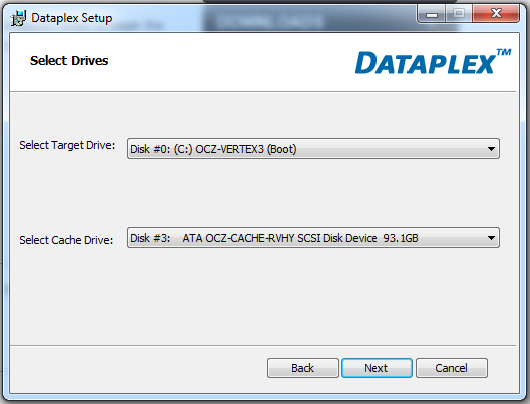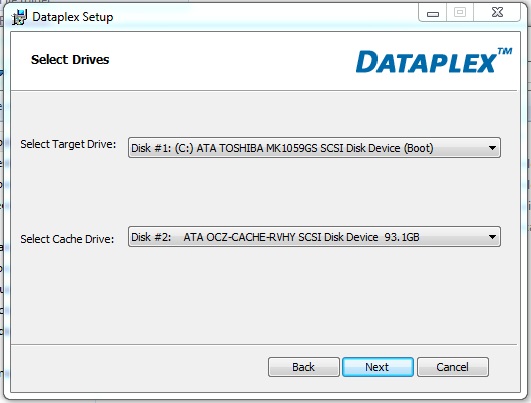OCZ RevoDrive Hybrid: Solid-State Speed With Hard Drive Capacity
Software Side: Caching Powered By Nvelo's Dataplex
For caching, OCZ leverages Nvelo's Dataplex. As far as software caching solutions go, this one is a little different. Intel's Smart Response Technology attempts to intelligently cache hot (frequently-used) blocks, leaving data it considers to be one-touch (unlikely to be requested again) on the hard drive. This is a natural consequence of the fact that Intel's caching implementation is tied to low cost and its 20 GB SSD 311. Just because it makes caching more accessible to mainstream customers doesn't mean Intel's approach is the most efficient, though. In contrast, OCZ's caching approach is not married to the valuation of the data. Instead, if data is accessed often, regardless of the pattern, it gets cached.
Another major difference between Intel's Smart Response Technology and OCZ's solution is the write-caching policies they use. The RevoDrive Hybrid is claimed to be a performance-driven caching product, which is why you pay $500 for it. As such, the Dataplex software controlling it is limited to write-back caching. Intel, on the other hand, lets you choose between a write-through (which it calls Enhanced) or write-back (also known as Maximized) strategy.
The difference is that write-through caching synchronously writes to the NAND and the hard drive. While you can still get significant performance gains in reads, naturally, writes slow down to the speed of a slow, 5400 RPM notebook drive, and there's nothing sexy about that. In a write-back configuration, however, the cache is written to first. Information is only moved to the hard drive when it's evicted from cache. As a result, writes do speed up, especially when you're working with a big 100 GB cache (rather than a smaller 20 GB one).
Now, write-back caching isn't necessarily faster. In a write-back cache, you have more cache management going on, tracking locations being written over. Given the overhead, write-through caching can be faster, especially when you're pushing a lot of random I/O. In lighter loads characterized by sequential workloads, however, write-back is the way to go.
If you've experimented with caching on a Z68 platform, you'll find the RevoDrive Hybrid to be a bit more restrictive (or, you could call it more specific). The Dataplex software only allows you to cache the boot drive. This means caching can only be enabled when you install Windows to the RevoDrive Hybrid and boot from it. As a secondary drive, it's possible to manually access the SSD and hard drive portions of the RevoDrive Hybrid separately, but they won't operate cooperatively as a caching solution.
If you try to enable caching with the Hybrid installed as a secondary drive, you can only cache your existing boot drive. This is kind of pointless, because you're losing out on the low-latency transfer that occurs within the RevoDrive Hybrid.
Get Tom's Hardware's best news and in-depth reviews, straight to your inbox.
Current page: Software Side: Caching Powered By Nvelo's Dataplex
Prev Page The Hardware: RevoDrive 3 And A 1 TB Hard Drive Next Page Test Setup And Benchmarks-
LuckyDucky7 Except for those who don't have SATA 6GB/s controllers on their motherboards, this product is a little redundant.Reply
I mean, it's really cool and all, but since Vertex 3 drives on their own run about 200 bucks for 120GB, you could get 2 x OCZ Vertex 3's in RAID, and a high-performance 1TB 7200 RPM drive like the Western Digital Caviar Black (the one mounted there is 5400RPM) for the same price as this drive.
So instead of the rather limited 120GB, you'd get 240GB of SSD storage instead, along with a faster hard drive. Because with 240GB, who needs cache? -
zybch LuckyDucky7Except for those who don't have SATA 6GB/s controllers on their motherboards, this product is a little redundant.I mean, it's really cool and all, but since Vertex 3 drives on their own run about 200 bucks for 120GB, you could get 2 x OCZ Vertex 3's in RAID, and a high-performance 1TB 7200 RPM drive like the Western Digital Caviar Black (the one mounted there is 5400RPM) for the same price as this drive.So instead of the rather limited 120GB, you'd get 240GB of SSD storage instead, along with a faster hard drive. Because with 240GB, who needs cache?Yeah, like i want to use 'scary'RAID in my system. Screw that.Reply -
alidan zybchYeah, like i want to use 'scary'RAID in my system. Screw that.Reply
than i believe use a raid 5, i think thats it, raid the 2 ssds and get another hdd in there as a backup for the two ssds -
rantoc alidanthan i believe use a raid 5, i think thats it, raid the 2 ssds and get another hdd in there as a backup for the two ssdsReply
For a raid 5 at least 3 drives is needed. And the chipset integrated raid5 solutions don't have powerful checksum offloading either meaning its either slow or hogs the cpu. Sure raid 5 is awesome in its ways but it also has its drawbacks. -
billybobser Just raid 0 and actively backup important files yourself if you can't take the drawbacks of it.Reply
If something just created is really worth saving, save it twice. Else just a back up image per week. -
shqtth This should be compared with the Seagate Momentus XT, where's that?Reply
..
It should be !
Also why use 5400rpm? why not 7200rpm? Or use the XT.
To me, this product looks like its hurting. Overpriced.
I tested a few of the XT's are they are quick. Pretty much constant 100+ data and super low latency on common tasks. -
Reynod Could you please look at a direct comparison with the Momentus XT please?Reply
I have one as well.
From what I can see this is a bit better than the XT but it would be good to know Andrew.
Cheers ! -
nebun zybchYeah, like i want to use 'scary'RAID in my system. Screw that.download the correct drivers and set it up correctly and you will have no issues....i have been using raid 0 for over 5 years with no issues at allReply



